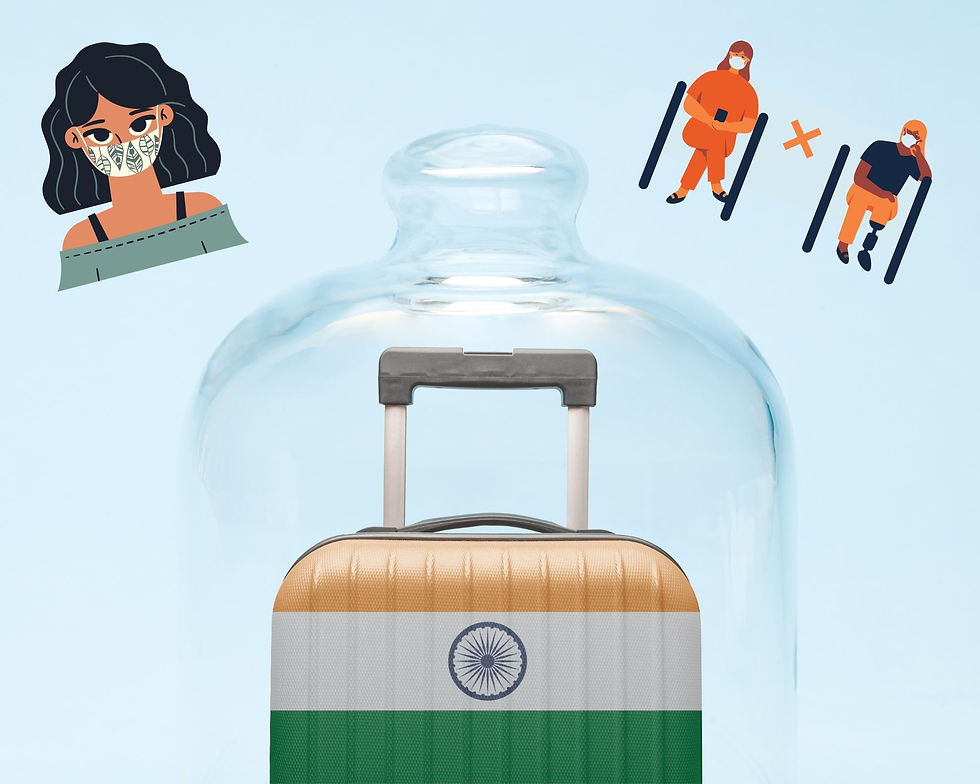"Travel is fatal to prejudice, bigotry, and narrow-mindedness, and many of our people need it sorely on these accounts. Broad, wholesome, charitable views of men and things cannot be acquired by vegetating in one little corner of Earth all one's lifetime." - Mark Twain
Tourism plays an vital role in social behaviorism, interactions, and is a strategic pillar in the economic growth of a nation. It is a vibrant, vast, dynamic and development-oriented industry. It connects several other sectors like hospitality, transportation, food and beverages among others. But CoVid-19 has brought a sudden pause to the choral hymns of this sector.

In December 2019, Coronavirus disease hit Wuhan, the capital city of Hubei province of central China. The first lockdown (for the containment of the virus), was implemented on the 23rd of January, 2020. By May 2020, over 90% of people worldwide were under travel restrictions. Due to this prevailing CoVid-19 situation, the future of tourism has become uncertain with many experts claiming that normalcy in tourism may never return.
Tourism today stands in a completely different reality and has to be investigated empirically. 'Non-interaction' has taken its root in our everyday social life and social identity linked to tourism has been affected majorly. According to the constructive ground theory approach, non-interaction between people and places influences each other. The changes are indeed influenced by social identity during crises like these and will shape our future social behavior too.
What's changing for tourism?
The Consumer Behavior :
A safe and hygienic environment has become the priority for people while travelling within the country. There is an increased preference for safe and healthy environment having low transmission risk. This can be seen in the preference to travel to low density areas especially in hilly areas of a country. Places with character of mindfulness and vacations at yogic retreats are showing increased demand. The pandemic has resulted in the affluent exploring vaccine tourism too.
Staycations and Personalized Journey :
The new normal is going to be centered around self-preservation and wellness in all possible ways as maintaining prime health is going to be the priority for every traveler. To get a break from all the clutter and chaos of city life, people are looking to travel up in the mountains for a pollution-free and safe environment.
The burgeoning middle class will tend to save and are preferring road trips over train and flight journeys. This may help in boosting travel through personal vehicles. International travel is restricted and the vanishing savings of middle class will have have positive correlation to increase in domestic tourism . People are increasingly going to prefer traveling to places closer to home for the foreseeable future. There has also been an increase in demand for longer duration stays at BnBs (Bed and Breakfast) among the working class seeking to work from remote areas.
Digital interactions:
The pandemic has given rise to number of start-ups and experiments in the digital tourism space. Use of VR headsets and access to Internet has opened up the possibility to explore tourism in digital replicas and exploring new realities altogether. The tourism industry was already experimenting with digital interaction for tourists and this has given the industry an innovative nudge.
Governance:
Amid CoVid-19 crises, the governments are primarily focused on immunity passport and are likely to give travel relaxation to those who are healthy and vaccinated. The new normal would be wearing a mask and personal sanitization is going to take priority for the hospitality industry . The government's focus can also be to promote travel in scattered geographies giving more economic opportunities to people of the areas least affected by the prevailing conditions.
Loss of Jobs:
The CoVid-19 pandemic has majorly impacted the economic growth and development around the globe. International tourism has been brought to a halt affecting cultural exchange among nations. The loss of jobs in hospitality and tourism has soared and the airline industry has been affected significantly.
Normalizing Tourism
Strengthening Global Supply Chains : Supply chains are being oriented towards movement of medical equipment and vaccines. The international COVAX alliance is also ensuring equitable global access to vaccines but is falling short of its goals at the moment. In this regard, the government of India started the Vande Bharat mission to bring back Indian citizen stranded abroad amidst the pandemic. Vaccine Maitri has been launched for sending vaccines to various countries and Operation Samudra Setu II was started for bringing medical oxygen from other countries during the second wave of infections.
Embracing Innovation and Good Practices : There will be a need for contactless tourism which can be possible due to innovations like digital tourism, video conferences and new travel technologies. Supply chains resilience will help businesses in treading the new path for the uncertain environment. The new normal would shift towards glocalization and adoption of best practices such as Indian culture of 'Namaskar' - joining hands for greetings rather than a handshake are being embraced. Similarly, the practice of wearing masks should become a behavioral change as is the case in Japan.
Information and Technology Access : Access to updated data and changes in regulations, security issues and safety protocols is a must. Contactless services issued at the airport and voice-controlled elevators would be part of the new normal. This is the source of confidence and security for the travelers.
Governments can evenly channel tourism using various parameters to supplement algorithms for better management of tourists. Feedback for specific locations should be available on the government websites enabling sustainable tourism management and development. Some suggested parameters for measurement could be:
- Air quality
- Hygiene and cleanliness index
- Transmission risk analysis
- Vaccination rates
- Demographics
References:
Author : Mehak Mahajan LinkedIn Profile : https://www.linkedin.com/in/mehak-mahajan-287389194/

